Work in progress
The content of this page was not yet updated for Godot
4.2
and may be outdated. If you know how to improve this page or you can confirm
that it's up to date, feel free to open a pull request.
Анимация персонажей¶
В этом заключительном уроке мы используем встроенные в Godot инструменты анимации, чтобы заставить наших персонажей плавать и махать руками. Вы научитесь создавать анимацию в редакторе и использовать код, чтобы ваша игра стала живой.

Мы начнем с введения в использование редактора анимации.
Использование редактора анимаций¶
Движок поставляется с инструментами для создания анимаций в редакторе. Затем вы можете использовать код для воспроизведения и управления ими во время выполнения.
Open the player scene, select the Player node, and add an AnimationPlayer node.
На нижней панели появится вкладка Animation.

В ней есть панель инструментов и раскрывающееся меню анимации в верхней части, редактор дорожек в середине, который в настоящее время пуст, и опции фильтрации, привязки и масштабирования в нижней части.
Давайте создадим анимацию. Щёлкните на Animation -> New.

Назовите анимацию "float".
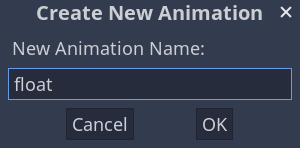
Once you've created the animation, the timeline appears with numbers representing time in seconds.

Мы хотим, чтобы анимация начинала воспроизводиться автоматически в начале игры. Кроме того, она должна быть зациклена.
Для этого можно нажать кнопку с пиктограммой "A+" на панели инструментов анимации и зацикленные стрелки соответственно.

Вы также можете закрепить редактор анимации, нажав на значок булавки в правом верхнем углу. Это предотвратит его сворачивание при нажатии на область просмотра и отмене выбора узлов.
![]()
Установите длительность анимации 1.2 секунды в правом верхнем углу панели.

Вы должны увидеть, как серая лента немного расширится. Она показывает начало и конец вашей анимации, а вертикальная синяя линия - это ваш временной курсор.

Вы можете щелкнуть и перетащить ползунок в правом нижнем углу, чтобы увеличить или уменьшить масштаб временной шкалы.
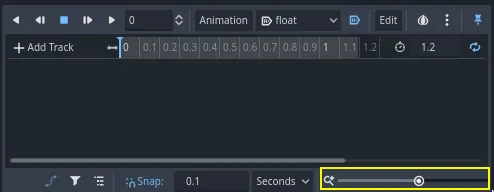
Плавающая анимация¶
С помощью узла анимации игрока вы можете анимировать большинство свойств на стольких узлах, сколько вам нужно. Обратите внимание на значок ключа рядом со свойствами в инспекторе. Вы можете щёлкнуть любой из них, чтобы создать ключевой кадр - пару времени и значения для соответствующего свойства. Ключевой кадр будет вставлен туда, где находится курсор времени на временной шкале.
Let's insert our first keys. Here, we will animate both the position and the
rotation of the Character node.
Select the Character and in the Inspector expand the Transform section. Click the key icon next to Position, and Rotation.
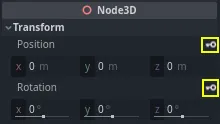

For this tutorial, just create RESET Track(s) which is the default choice
В редакторе появятся две дорожки с ромбовидным значком, обозначающим каждый ключевой кадр.

You can click and drag on the diamonds to move them in time. Move the
position key to 0.3 seconds and the rotation key to 0.1 seconds.

Move the time cursor to 0.5 seconds by clicking and dragging on the gray
timeline.

In the Inspector, set the Position's Y axis to 0.65 meters and the Rotation' X axis to 8.
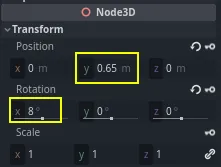
Create a keyframe for both properties
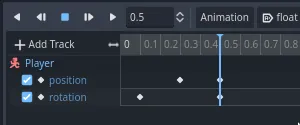
Now, move the position keyframe to 0.7
seconds by dragging it on the timeline.
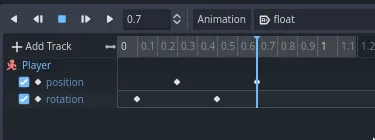
Примечание
Лекция о принципах анимации выходит за рамки данного руководства. Просто отметим, что вы не хотите равномерно распределять время и пространство. Вместо этого аниматоры играют с таймингом и интервалом - двумя основными принципами анимации. Вы хотите смещать и контрастировать движения персонажа, чтобы сделать их живыми.
Move the time cursor to the end of the animation, at 1.2 seconds. Set the Y
position to about 0.35 and the X rotation to -9 degrees. Once again,
create a key for both properties.

Вы можете просмотреть результат, нажав на кнопку воспроизведения или нажав Shift + D. Нажмите кнопку "Stop" или нажмите S, чтобы остановить воспроизведение.

Вы можете видеть, что движок интерполируется между вашими ключевыми кадрами для создания непрерывной анимации. Однако на данный момент движение кажется очень роботизированным. Это происходит потому, что интерполяция по умолчанию линейная, что приводит к постоянным переходам, в отличие от того, как живые существа двигаются в реальном мире.
Мы можем управлять переходом между ключевыми кадрами с помощью кривых смягчения.
Щёлкните и перетащите вокруг первых двух ключей на временной шкале, чтобы выделить их.

Вы можете редактировать свойства обеих ключей одновременно в инспекторе, где вы можете увидеть свойство Easing.

Щёлкните и перетащите кривую, потянув её влево. Это заставит её ослабнуть, то есть сначала переход будет быстрым, а затем замедлится, когда курсор времени достигнет следующего ключевого кадра.

Воспроизведите анимацию ещё раз, чтобы увидеть разницу. Первая половина уже должна казаться немного более подпрыгивающей.
Примените ослабление ко второму ключевому кадру на дорожке вращения.
Do the opposite for the second position keyframe, dragging it to the right.
Ваша анимация должна выглядеть примерно так.
Примечание
Анимации обновляют свойства анимируемых узлов каждый кадр, переопределяя начальные значения. Если бы мы напрямую анимировали узел Player, это не позволило бы нам перемещать его в коде. Именно здесь пригодится узел Pivot: даже если мы анимировали Character, мы все равно можем перемещать и вращать Pivot и накладывать изменения поверх анимации в сценарии.
Если вы играете в игру, то существо игрока теперь будет плавать!
If the creature is a little too close to the floor, you can move the Pivot up
to offset it.
Управление анимацией в коде¶
Мы можем использовать код для управления воспроизведением анимации на основе ввода данных игроком. Давайте изменим скорость анимации, когда персонаж движется.
Open the Player's script by clicking the script icon next to it.
В _physics_process(), после строки, где мы проверяем вектор direction, добавьте следующий код.
func _physics_process(delta):
#...
if direction != Vector3.ZERO:
#...
$AnimationPlayer.speed_scale = 4
else:
$AnimationPlayer.speed_scale = 1
public override void _PhysicsProcess(double delta)
{
// ...
if (direction != Vector3.Zero)
{
// ...
GetNode<AnimationPlayer>("AnimationPlayer").SpeedScale = 4;
}
else
{
GetNode<AnimationPlayer>("AnimationPlayer").SpeedScale = 1;
}
}
Этот код делает так, что когда игрок движется, мы умножаем скорость воспроизведения на 4. Когда они останавливаются, мы восстанавливаем нормальное значение.
We mentioned that the Pivot could layer transforms on top of the animation. We
can make the character arc when jumping using the following line of code. Add it
at the end of _physics_process().
func _physics_process(delta):
#...
$Pivot.rotation.x = PI / 6 * velocity.y / jump_impulse
public override void _PhysicsProcess(double delta)
{
// ...
var pivot = GetNode<Node3D>("Pivot");
pivot.Rotation = new Vector3(Mathf.Pi / 6.0f * Velocity.Y / JumpImpulse, pivot.Rotation.Y, pivot.Rotation.Z);
}
Анимация мобов¶
Вот ещё один приятный приём с анимациями в Godot: пока вы используете похожую структуру узлов, вы можете копировать их в разные сцены.
For example, both the Mob and the Player scenes have a Pivot and a
Character node, so we can reuse animations between them.
Open the Player scene, select the AnimationPlayer node and open the "float"
animation. Next, click on Animation > Copy. Then open mob.tscn,
create an AnimationPlayer child node and select it. Click Animation > Paste
and make sure that the button with an "A+" icon (Autoplay on Load) and the
looping arrows (Animation looping) are also turned on in the animation editor
in the bottom panel. That's it; all monsters will now play the float animation.
Мы можем изменить скорость воспроизведения в зависимости от random_speed существа. Откройте скрипт Mob и в конце функции initialize() добавьте следующую строку.
func initialize(start_position, player_position):
#...
$AnimationPlayer.speed_scale = random_speed / min_speed
public void Initialize(Vector3 startPosition, Vector3 playerPosition)
{
// ...
GetNode<AnimationPlayer>("AnimationPlayer").SpeedScale = randomSpeed / MinSpeed;
}
И на этом вы закончили написание кода для своей первой полноценной 3D-игры.
Поздравляем!
В следующей части мы быстро подведём итоги того, что вы узнали, и дадим вам несколько ссылок для дальнейшего изучения. Но пока что здесь представлены полные версии Player.gd и Mob.gd, чтобы вы могли сверить с ними свой код.
Вот скрипт Player.
extends CharacterBody3D
signal hit
# How fast the player moves in meters per second.
@export var speed = 14
# The downward acceleration while in the air, in meters per second squared.
@export var fall_acceleration = 75
# Vertical impulse applied to the character upon jumping in meters per second.
@export var jump_impulse = 20
# Vertical impulse applied to the character upon bouncing over a mob
# in meters per second.
@export var bounce_impulse = 16
var target_velocity = Vector3.ZERO
func _physics_process(delta):
# We create a local variable to store the input direction
var direction = Vector3.ZERO
# We check for each move input and update the direction accordingly
if Input.is_action_pressed("move_right"):
direction.x = direction.x + 1
if Input.is_action_pressed("move_left"):
direction.x = direction.x - 1
if Input.is_action_pressed("move_back"):
# Notice how we are working with the vector's x and z axes.
# In 3D, the XZ plane is the ground plane.
direction.z = direction.z + 1
if Input.is_action_pressed("move_forward"):
direction.z = direction.z - 1
# Prevent diagonal movement being very fast
if direction != Vector3.ZERO:
direction = direction.normalized()
$Pivot.look_at(position + direction,Vector3.UP)
$AnimationPlayer.speed_scale = 4
else:
$AnimationPlayer.speed_scale = 1
# Ground Velocity
target_velocity.x = direction.x * speed
target_velocity.z = direction.z * speed
# Vertical Velocity
if not is_on_floor(): # If in the air, fall towards the floor
target_velocity.y = target_velocity.y - (fall_acceleration * delta)
# Jumping.
if is_on_floor() and Input.is_action_just_pressed("jump"):
target_velocity.y = jump_impulse
# Iterate through all collisions that occurred this frame
# in C this would be for(int i = 0; i < collisions.Count; i++)
for index in range(get_slide_collision_count()):
# We get one of the collisions with the player
var collision = get_slide_collision(index)
# If the collision is with ground
if collision.get_collider() == null:
continue
# If the collider is with a mob
if collision.get_collider().is_in_group("mob"):
var mob = collision.get_collider()
# we check that we are hitting it from above.
if Vector3.UP.dot(collision.get_normal()) > 0.1:
# If so, we squash it and bounce.
mob.squash()
target_velocity.y = bounce_impulse
# Prevent further duplicate calls.
break
# Moving the Character
velocity = target_velocity
move_and_slide()
$Pivot.rotation.x = PI / 6 * velocity.y / jump_impulse
# And this function at the bottom.
func die():
hit.emit()
queue_free()
func _on_mob_detector_body_entered(body):
die()
using Godot;
public partial class Player : CharacterBody3D
{
// Emitted when the player was hit by a mob.
[Signal]
public delegate void HitEventHandler();
// How fast the player moves in meters per second.
[Export]
public int Speed { get; set; } = 14;
// The downward acceleration when in the air, in meters per second squared.
[Export]
public int FallAcceleration { get; set; } = 75;
// Vertical impulse applied to the character upon jumping in meters per second.
[Export]
public int JumpImpulse { get; set; } = 20;
// Vertical impulse applied to the character upon bouncing over a mob in meters per second.
[Export]
public int BounceImpulse { get; set; } = 16;
private Vector3 _targetVelocity = Vector3.Zero;
public override void _PhysicsProcess(double delta)
{
// We create a local variable to store the input direction.
var direction = Vector3.Zero;
// We check for each move input and update the direction accordingly.
if (Input.IsActionPressed("move_right"))
{
direction.X += 1.0f;
}
if (Input.IsActionPressed("move_left"))
{
direction.X -= 1.0f;
}
if (Input.IsActionPressed("move_back"))
{
// Notice how we are working with the vector's X and Z axes.
// In 3D, the XZ plane is the ground plane.
direction.Z += 1.0f;
}
if (Input.IsActionPressed("move_forward"))
{
direction.Z -= 1.0f;
}
// Prevent diagonal movement being very fast.
if (direction != Vector3.Zero)
{
direction = direction.Normalized();
GetNode<Node3D>("Pivot").LookAt(Position + direction, Vector3.Up);
GetNode<AnimationPlayer>("AnimationPlayer").PlaybackSpeed = 4;
}
else
{
GetNode<AnimationPlayer>("AnimationPlayer").PlaybackSpeed = 1;
}
// Ground velocity
_targetVelocity.X = direction.X * Speed;
_targetVelocity.Z = direction.Z * Speed;
// Vertical velocity
if (!IsOnFloor())
{
_targetVelocity.Y -= FallAcceleration * (float)delta;
}
// Jumping.
if (IsOnFloor() && Input.IsActionJustPressed("jump"))
{
_targetVelocity.Y += JumpImpulse;
}
// Iterate through all collisions that occurred this frame.
for (int index = 0; index < GetSlideCollisionCount(); index++)
{
// We get one of the collisions with the player.
KinematicCollision3D collision = GetSlideCollision(index);
// If the collision is with a mob.
if (collision.GetCollider() is Mob mob)
{
// We check that we are hitting it from above.
if (Vector3.Up.Dot(collision.GetNormal()) > 0.1f)
{
// If so, we squash it and bounce.
mob.Squash();
_targetVelocity.Y = BounceImpulse;
// Prevent further duplicate calls.
break;
}
}
}
// Moving the character
Velocity = _targetVelocity;
MoveAndSlide();
var pivot = GetNode<Node3D>("Pivot");
pivot.Rotation = new Vector3(Mathf.Pi / 6.0f * Velocity.Y / JumpImpulse, pivot.Rotation.Y, pivot.Rotation.Z);
}
private void Die()
{
EmitSignal(SignalName.Hit);
QueueFree();
}
private void OnMobDetectorBodyEntered(Node body)
{
Die();
}
}
И скрипт Mob.
extends CharacterBody3D
# Minimum speed of the mob in meters per second.
@export var min_speed = 10
# Maximum speed of the mob in meters per second.
@export var max_speed = 18
# Emitted when the player jumped on the mob
signal squashed
func _physics_process(_delta):
move_and_slide()
# This function will be called from the Main scene.
func initialize(start_position, player_position):
# We position the mob by placing it at start_position
# and rotate it towards player_position, so it looks at the player.
look_at_from_position(start_position, player_position, Vector3.UP)
# Rotate this mob randomly within range of -90 and +90 degrees,
# so that it doesn't move directly towards the player.
rotate_y(randf_range(-PI / 4, PI / 4))
# We calculate a random speed (integer)
var random_speed = randi_range(min_speed, max_speed)
# We calculate a forward velocity that represents the speed.
velocity = Vector3.FORWARD * random_speed
# We then rotate the velocity vector based on the mob's Y rotation
# in order to move in the direction the mob is looking.
velocity = velocity.rotated(Vector3.UP, rotation.y)
$AnimationPlayer.speed_scale = random_speed / min_speed
func _on_visible_on_screen_notifier_3d_screen_exited():
queue_free()
func squash():
squashed.emit()
queue_free() # Destroy this node
using Godot;
public partial class Mob : CharacterBody3D
{
// Emitted when the played jumped on the mob.
[Signal]
public delegate void SquashedEventHandler();
// Minimum speed of the mob in meters per second
[Export]
public int MinSpeed { get; set; } = 10;
// Maximum speed of the mob in meters per second
[Export]
public int MaxSpeed { get; set; } = 18;
public override void _PhysicsProcess(double delta)
{
MoveAndSlide();
}
// This function will be called from the Main scene.
public void Initialize(Vector3 startPosition, Vector3 playerPosition)
{
// We position the mob by placing it at startPosition
// and rotate it towards playerPosition, so it looks at the player.
LookAtFromPosition(startPosition, playerPosition, Vector3.Up);
// Rotate this mob randomly within range of -90 and +90 degrees,
// so that it doesn't move directly towards the player.
RotateY((float)GD.RandRange(-Mathf.Pi / 4.0, Mathf.Pi / 4.0));
// We calculate a random speed (integer).
int randomSpeed = GD.RandRange(MinSpeed, MaxSpeed);
// We calculate a forward velocity that represents the speed.
Velocity = Vector3.Forward * randomSpeed;
// We then rotate the velocity vector based on the mob's Y rotation
// in order to move in the direction the mob is looking.
Velocity = Velocity.Rotated(Vector3.Up, Rotation.Y);
GetNode<AnimationPlayer>("AnimationPlayer").SpeedScale = randomSpeed / MinSpeed;
}
public void Squash()
{
EmitSignal(SignalName.Squashed);
QueueFree(); // Destroy this node
}
private void OnVisibilityNotifierScreenExited()
{
QueueFree();
}
}